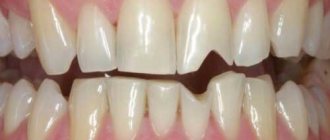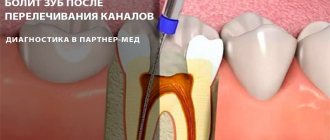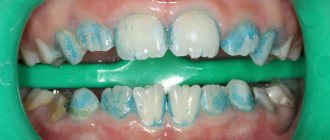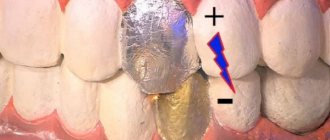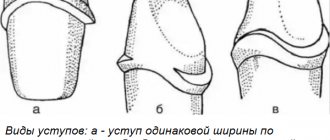Restoring the upper front teeth requires special responsibility from the dentist, because they bear increased load when biting food and are most visible when smiling.
Therefore, the treatment must not only be of high quality, but also not leave traces of the presence of a foreign composition. Let's look at what fillings for the front teeth are, how they are installed and how much it costs.
Features of filling anterior teeth
From a medical point of view, filling frontal molars is no different from all others. However, in the case of such therapy, the importance of the aesthetic component of the filling for the patient increases.
If the chewing organ is severely damaged, the dentist may recommend orthopedic treatment, even if a crown is not necessary from the point of view of the normal functioning of the masticatory system.
This measure is chosen by those patients for whom appearance plays a particularly important role.
How much does the procedure cost?
The exact cost of dental filling is usually announced by the doctor at the initial consultation. The price will depend on the filling material used and the amount of work. Filling canals will cost more than simply installing a filling.
| Type of filling | Price |
| Cement filling | From 900 rubles |
| Glass ionomer filling | From 1,500 rubles |
| Filling made from a light-curing composite of the latest generation | From 3,500 rubles |
| Filling made from a chemocurable composite of the latest generation | From 2,500 rubles |
Types of suitable fillings
Modern dentistry offers a large selection of filling materials, differing in their properties and, of course, price:
| Name | Modern materials | Properties, advantages and disadvantages |
| Cement fillings | glass ionomer | This composition of fillings is characterized by good integration with natural tissues, which ensures the reliability of the insert and, subject to careful treatment of the drilled cavity, reduces the threat of recurrent caries in the patient. |
| Compomers | hybrid version of glass ionomers and composite ingredients | Aesthetically identical to enamel, high-quality materials are excellent for plastic surgery of anterior molars after chipping. The only downside of fillings is that they are not strong enough, so after filling, the dentist advises not to overload the affected molar. |
| Photopolymer | mixed organic and inorganic compounds that harden when exposed to light | These are the most common filling options for front teeth. The composition quickly hardens under the influence of an ultraviolet lamp. By adding or subtracting various ingredients, the dentist can easily select the desired color to match the dentition, so such cosmetic fillings are also invisible to others. |
| Metal | gold, copper, silver | Metal structures are the most durable. On the other hand, they are unaesthetic, shrink due to the chewing load and are not tightly attached to the dental crown, which is fraught with repeated caries. The use of material for the anterior masticatory organs is rare. |
| Plastic | acrylic-containing plastics, carbondent | Plastic analogues quickly harden, are characterized by increased strength, are resistant to chemical reagents, and do not have a negative effect on the patient’s oral cavity. However, the composition is prone to wear and does not hold the shade well enough. Over time, such a tooth will darken. |
| Silicate | silicate cement | These types of fillings are budget ones. They are quite durable. However, they have weakened adhesion, which is fraught with re-infection of the molar, and can release toxic substances. |
| Chemical | the main component in them is porcelain | The material is durable and is characterized by uniform hardening during a chemical reaction with the oral cavity and auxiliary components. Due to increased adhesion, the filling is almost invisible on the surface, which makes it aesthetically attractive. |
| Temporary fillings | dentin, softened paste, cariosan, vinoxol | Modern temporary filling materials are used during long-term therapy to fill the cavity so that the patient can chew comfortably. This option is not suitable for permanent use due to aesthetic imperfections, poor strength and insufficient integration. |
All of the listed filling compositions can be used in the dental treatment of anterior molars. Their pros and cons appear depending on the location of the caries and its size.
In general, when there is more damage, stronger compounds are used, and when there is a small chip, more natural and aesthetically attractive ones are used.
Treatment methods – from filling to implant
The dentist will select the treatment method for the front teeth after an examination.
- Veneers or Lumineers
If the incisors are severely damaged, thin overlays can be placed - veneers or lumineers. They will hide the consequences of caries and make teeth whiter and smoother.
- Dental crowns
If only the root remains of the front tooth, intra-root inlays are made; this is the basis for the crown. Metal crowns are not suitable for front teeth; they will be too noticeable. To make an artificial tooth as similar as possible to a real one, it is better to use ceramic and zirconium crowns.
- Bridges and implants
If desired, missing front teeth can be replaced by bridges and clasp dentures. If funds allow, you can install an implant and forget about the problem for many years.
The best option for filling anterior teeth
In modern dentistry, a light filling is most often used. During its installation, the dentist uses an ultraviolet lamp, under the influence of which the material acquires the necessary strength and eliminates microflora in the cavity.
The advantages of this filling option are as follows:
- Front teeth with caries
after visiting the dentist, you can immediately drink and eat;
- the dense composition of the filling is better integrated into the dental cavity, it has good adhesive ability;
- components of increased strength and durability will last at least 5 years or even more, subject to careful handling of the chewing organs and careful oral care;
- the components of the filling will not poison the body with toxins;
- the chemical properties of the substance allow you to choose a color identical to tooth enamel.
Note! Lighting composites do not require long preparation. In the absence of complications, the patient is treated with modern material in the clinic in one session.
What to do if a filling falls out of a tooth
Regardless of which filling has fallen out - temporary or permanent - you need to make an appointment with a therapist as soon as possible. If you ignore the problem or self-medicate, you can lose your tooth.
If a permanent filling falls out, follow these recommendations:
- Try to eat on the other side of the jaw so that as few germs as possible enter the cavity;
- Don't eat hard, sticky foods;
- After eating, use an antiseptic rinse solution;
- Do not try to clean the cavity with a toothbrush. This may damage the tissue.
- If the caries is deep, the tooth hurts, sensitivity to hot and cold increases, take painkillers.
If you lose a temporary filling from a living or dead tooth, cover the cavity with a piece of cotton wool. Be careful when cleaning and rinsing your mouth so as not to wash out the tampon. Don't delay your visit to the dentist. The longer you go without a filling, the deeper the cavity will form and the more expensive the treatment will be.
Preparing for installation
When installing a light filling, the dentist uses an ultraviolet lamp
First, the dentist examines the patient’s dentition and identifies other defects. Next, the therapist examines the problematic front tooth.
If deep caries is suspected, a photograph is taken. In case of a confirmed complication, the molar is depulped and the canals are cleaned, followed by filling.
The procedure is necessarily accompanied by modern anesthesia.
In this case, treatment usually lasts for 2-3 visits to the dentist, because after treatment of the dental canal you need to wait for the root reaction.
If the patient does not feel any discomfort and the control image shows that the canals are sealed correctly, the doctor proceeds to install a permanent structure.
Teeth filling process
- Initial consultation, taking x-rays.
- Coordination of treatment methods and selection of the type of fillings to be installed.
- Anesthesia before therapeutic intervention (local anesthesia, sedation, in rare cases - general anesthesia).
- Preparation of damaged or caries-affected tooth tissues.
- Grinding and processing the surface of the filling for proper closure.
Filling temporary teeth (baby teeth) follows the same plan, however, in pediatric dentistry, more compatible and safe materials are used.
Installation: main steps
Filling of the anterior molar occurs in stages over 30-60 minutes, depending on the depth of the lesion:
- Preparation for installation and option after filling
To prepare the tooth plane on which the composition will be held, the dentist once again processes it with a drill. This will not require the patient to be anesthetized.
- Then the cavity is treated with antiseptics so that there are no microbes under the frame that provoke recurrent caries.
- Next, the dentist mixes the filling material and spreads it on the surface to be treated. The composition must be shrinked with a special tool for the most durable bonding.
- When placing a photopolymer filling, the cavity is treated with ultraviolet light. Under the influence of radiation, the composition hardens.
- At the final stage, the dentist asks the patient to bite on a special plate with dye to check the bite. If there is a violation, the “extra” part will be tinted.
- The dentist carefully drills out the unnecessary element of the filling using a drill with a special grinding attachment, polishing the filling. At the same time, the planes are given smoothness to prevent the accumulation of microbes in cracks, which is fraught with tartar.
- After completion of work, many clinics conduct a control X-ray examination. This is necessary to check the results.
In the next 2-4 days, the filling may make itself felt with a slight aching pain. This is not a complication and goes away on its own.
Dental filling methods
All methods of filling teeth are based on the use of various materials, which have their own advantages and disadvantages. Therefore, when choosing a technology, the doctor focuses on the individual characteristics of the structure of the root canals and the patient’s body as a whole.
Filling teeth with gutta-percha
Removal of the nerve of the tooth and filling of the canals, when the cavity is filled with a special paste based on gutta-percha with the addition of various impurities. Despite its simplicity and relatively low cost, this method of filling teeth cannot be called reliable and safe. It is often accompanied by a violation of tightness, the development of inflammation and allergic reactions.
Using a pin
Filling a pulpless tooth with pins is one of the most common techniques in dentistry. There are two types of pins (fillers): gutta-percha and metal. Filling tooth canals with gutta-percha is considered a more reliable and safe method. Even taking into account the presence of polymers, dyes and metal salts, such pins are biocompatible and do not cause allergies. Silver metal structures have good flexibility and can be installed in long and curved channels, however, silver is prone to oxidation, which can lead to inflammation. Titanium posts are better in terms of tissue compatibility, but they are very rigid and require the preparation of a special bed, which makes the tooth walls extremely fragile.
Sealers-sealers
Even gutta-percha pins for filling the root canals of teeth by themselves are not able to provide a reliable result, since they do not have antibacterial properties. To improve the quality of filling, dentists use sealers - sealants that ensure a tight fit of the material to the canal walls. There are natural (based on cement, zinc oxide, etc.), polymer sealers, glass ionomer cements and pastes based on calcium hydroxide.
How much does it cost to put a filling on a front tooth?
The cost of installing a filling largely depends on the clinic.
On average, dental clinics issue bills with the following figures:
- reception and examination at the clinic - from 500 to 1500 rubles;
- X-ray and anesthesia - from 300 rubles. up to 1000 rub. subject to injection with standard novocaine or ultracaine;
- removal of caries and cleaning of the cavity - 1500-3000 rubles;
- staging - from 2000 to 6000 rubles. depending on the material;
- if it is necessary to remove the nerve and fill the canal, the cost increases by another 3000-5000 rubles.
Thus, the average price of a filling for a front tooth in a paid dental clinic varies from 4 to 16 thousand, depending on the diagnosis, the reputation of the company and the qualifications of the dentist.
Important! Many clinics offer various discounts and promotions that make therapy much cheaper.
Free medicine
Installing a free design will significantly save money, but the quality of the filling may suffer as a result.
In general, going to a clinic for free medical care is fraught with disadvantages:
- Modern free dentistry is more designed for people with limited financial resources
Firstly, municipal clinics save on costs , so during work they use the necessary minimum of equipment and tools, and there are no additional amenities. Such treatment will be a priori less comfortable.
- Secondly, filling components supplied by the state are usually cheaper than analogues used in private medicine, so they are less durable and more likely to cause recurrent caries.
- Thirdly, in a municipal clinic the salary is always lower than in a private one, so most dentists in free medicine are either young specialists working for experience, or older doctors of pre-retirement or retirement age.
Important! Specialists will carry out a full range of filling work, and the delivered structure will hold. However, it will look worse, have less strength and will fall out much earlier than the expensive material installed using modern equipment.
Why do you need dental filling?
The first experiments with the installation of fillings were carried out before our era. Holes in the teeth were filled with resin and various mixtures. However, the archaic technique of filling teeth brought almost no positive results. Fortunately, today everything has changed dramatically. Modern fillings are successfully used to perform a variety of tasks, in particular for:
- functional filling
- aesthetic dental filling
- filling root canals
- temporary sealing of a damaged tooth
Validity
Modern light fillings with high-quality treatment last for 7-10 years, after which either the tissue of the damaged tooth or the material itself is destroyed.
Then a repeat session is carried out, during which the tooth cavity expands even more, therefore, the strength of the walls decreases. Therefore, in a newly filled molar, even a modern composition will last 2-3 years less.
Before and after installing fillings on the front teeth
Replacement
After several replacements of the dropped insert, the walls become so thin that the therapist suggests installing a pin and a crown. This orthopedic treatment in the clinic will provide the patient with normal functioning of the damaged molar for another 8-12 years.
If your front tooth hurts after treatment
Patients often complain that their front teeth hurt after treatment. The dentist cleaned the canals, so this is normal. The discomfort should go away within a few hours. But if the treatment is done poorly, the tooth may hurt for a long time - and this is already a deviation from the norm. Most likely, the doctor made a mistake during treatment and the entire filling process will have to be repeated. The cause of pain can be a burn of the pulp, damage to the enamel, an allergy to medications, or acid contact with dentin.
Possible complications
Dental treatment, like any other medical intervention, can lead to complications.
Typically patients face the following problems:
- Dental treatment, like any other medical intervention, can lead to complications
infection of the opened cavity, which leads to the spread of pathogenic microflora under the filling and its loss ahead of time;
- penetration of infection into the root area, which is fraught with granuloma, cyst with subsequent loss of the masticatory organ;
- malocclusion due to improper grinding in the clinic;
- penetration of toxic filling materials into the area of the dental nerve, followed by pulpitis or peridontitis if the dental filling technique is violated.
To avoid complications, you should contact a reputable clinic and take precautions after filling a molar.
Why do fillings fall out?
An old filling falls out when its expiration date expires. But sometimes the filling can crumble or fall out prematurely. Let's list why this can happen:
- The treatment technology is broken . To securely fix the material, the surface must be dry. If moisture gets into the mixture during filling, the service life will be shortened. Also, when using light-polymer mixtures, the doctor may incorrectly set the lamp power, due to which the substance hardens. Then the top layer becomes dense, but the bottom one does not, and over time it begins to peel off.
- Secondary caries has developed . Due to the shrinkage of the filling, microcracks are formed between it and the dentin, into which bacteria penetrate. Caries destroys tissue, which leads to loss of fillings.
- The size of the filling is incorrectly selected . If it is too large or small, the adhesive ability is reduced, it is not firmly fixed and falls off.
- Low quality materials were used . If a filling is made from cheap composites, there is no guarantee that it will last as long as it should. Over time, pieces may begin to break off.
- The enamel is damaged . Fillings do not hold well if they are highly abraded and if there are chips or cracks.
- Poor hygiene . If the patient does not clean the plaque that accumulates on the teeth, the bacteria it contains destroys the enamel and causes premature loss of fillings.
Fillings often fall out on baby teeth. This happens for two reasons:
- A child cannot sit still for a long time , and for high-quality work it is necessary that he sit calmly in the dentist’s chair. The activity leads to the fact that saliva particles enter the cavity or the doctor cannot give the filling the desired shape. Then the adhesion of the composite to the tissue is unreliable, and it crumbles or chips.
- After treatment, it is recommended not to eat for 1-2 hours . Children often violate instructions.
Most of the reasons why fillings fall out are related to the actions of the dentist or the behavior of the patient. Therefore, when choosing a clinic, it is important to read reviews about doctors, clarify their experience and qualifications. You also need to monitor the condition of your oral cavity, undergo an annual examination and hygienic cleaning.
Popular questions
What to do if the filling composition has changed color (darkened, yellowed, blackened)? How to bleach?
The filling composition changes its color over time, just like tooth enamel. However, it is less susceptible to whitening with pastes and gels. Therefore, it is best to go to the clinic so that the doctor will bleach the filling using professional means or remove some material from the surface and replace it with a new one.
Is the filling visible after treatment?
With modern equipment and materials, photopolymers do not stand out in any way against the background of the dental surface of a molar.
What should you do if the filling on your front tooth falls out, peels off, or breaks off?
In this case, you need to make an appointment with the dentist for re-treatment. If the chip is small, the therapist will only sand it a little so that it does not deteriorate further and does not scratch the tongue. If a large part falls off or falls out completely, you will have to replace it entirely.
What to do if it was placed ugly?
Aesthetics is one of the important components of dental therapy. The patient has the right to demand re-treatment from the clinic administration.
What is a temporary filling for front teeth?
A temporary structure is placed for long-term treatment, which requires several sessions of visiting the dentist. Such a filling is needed to prevent food debris from packing into the opened cavity and for the patient’s convenience.
What is a bite filling for anterior teeth?
This is also a temporary analogue, only larger in size. It is necessary to wear it when wearing braces, so that when closing the chewing organs do not disturb the structure and do not deform it. Also, a bite filling is used for severe chips during long-term dental treatment.
Is it possible to build up a front tooth with a filling?
Modern filling compositions are designed not only for filling carious cavities, but also for restoration after chips. At the same time, the strength of the extended molar will allow you to bite and chew food normally.
What is better – a filling or a veneer?
Both technologies have pros and cons. In particular, veneers have better aesthetic properties and plaque does not settle on them, while filling takes less time and the filling lasts longer.
Before and after installing fillings on the front teeth
Advantages of a crown over a filling
You can often hear the opinion that before installing a crown, a good part of the tooth is ground down, and because of this, it quickly falls apart. This is wrong. A crown or veneer extends the life of a damaged row unit to 10-15 years. A large filling will have to be replaced after 3-4 years.
A crown is also better than a filling for the following reasons:
- the prosthesis is the same in color and shape as the natural tooth;
- a carefully made crown fits tightly to the enamel;
- dentures look more aesthetically pleasing than fillings.
A high-quality crown protects the tooth from further destruction. The filling has to be drilled out along with healthy tissue, which weakens the tooth.
Methodology
The restoration method is selected for each case separately, after a thorough examination by a specialist. The material is placed either in the cavity or on a special tab, fixed with glue.
Direct reconstruction involves the application of filling material to the prepared area, according to the rules and technology of the selected material.
Indirect reconstruction is carried out using inlays, which are made in the laboratory based on casts. The tab is then placed on the damaged area and cemented to ensure a complete seal.
For the direct method of restoring anterior teeth, light-hardening composites - fillings - are used. With the indirect method, the specialist has more choice: ceramics, metal-ceramics, zirconium dioxide. Crowns are traditionally made of zirconium and metal-ceramics.
What are we talking about?
Restoration of teeth with filling material. Sound familiar? Restoration usually refers to the process of restoration, giving an object its original appearance. So in dentistry, restoration is the restoration of the anatomical shape and color of teeth, while maintaining functionality.
This procedure is carried out at the end of treatment. Essentially, the tooth cavity is filled with a special solution, and then a filling is installed. It allows you to replace the missing area and leave the tooth fully functional.
The frontal group of teeth is restored using filling material for the following indications:
- enamel or tooth tissue is destroyed;
- chips appeared;
- color changes are noted;
- you need to level the surface of the crown;
- there is a gap between the teeth;
- it is necessary to restore the enamel after caries treatment.
